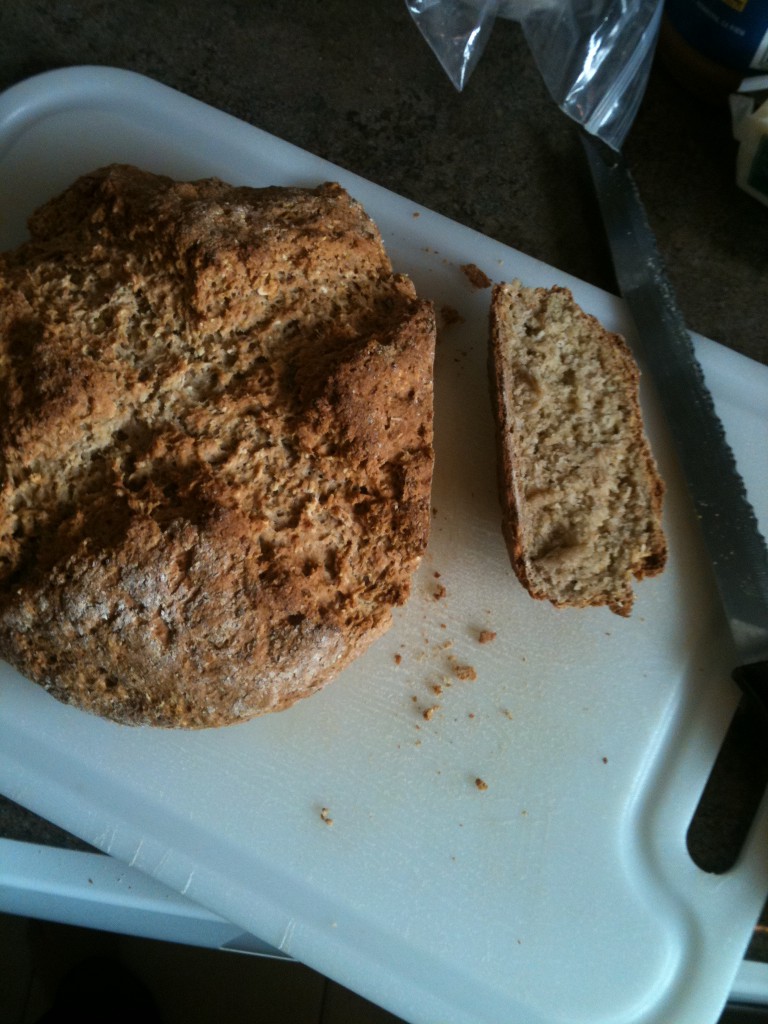 This is a totally non-writing related post!
This is a totally non-writing related post!
I mentioned, in today’s earlier post, that I’d made bread four times this past weekend — two soda breads and two batches of chapatti. Right now I’m enjoying the tail end of the first batch, toasted with a little butter. That plus a strong cup of (green) tea is making my whole morning.
Baking is one of my favorite things to do, and I’ve been experimenting a lot with wheat-free recipes because the Mr. and I can both overdo it on the wheat, and so we’ve been working to cut back. Still, homemade bread is a gorgeous thing — it brings a tremendous sense of ‘home’ for me, which, as you may know from reading earlier posts, is something I’m always searching for, so I hate to have to give up baking just because I’m trying to eat less wheat!
Some recipes lend themselves well to substitutions and experimentation — and soda bread is one of those. Soda bread is also a tremendously easy (in my experience) and rewarding bread. Mix up the wet ingredients, mix up the dry, mix the dry into the wet, knead for just a few minutes to form the dough into a nice ball, put the dough on the (just barely oiled) baking sheet, put in the deep criss-crossing cuts (to let the faeries out! :) and pop it in the oven. The whole thing can get done in an hour, once you’ve got your ingredients together, and then you’ve got fresh bread for your breakfast or supper. So good.
I’ve been using the Soda Bread/Spotted Dog recipe in Darina Allen’s Complete Book of Irish Country Cooking for years (another book of hers, The Forgotten Skills of Cooking, looks excellent, too!), adapting and altering as I go. Every time I make this bread, it’s different, because I’m always making substitutions based on what I have around when it’s time to bake. For instance, her recipe calls for buttermilk, which I never have occasion to find in my refrigerator. So I use yogurt or I sour the called-for amount of sweet milk (add about a tsp of vinegar or lemon juice and let it sit for a few minutes) or I just forgo the sourness altogether and use soy milk or regular (sweet) milk. Buttermilk powder is also good for this use — you can buy it in bulk at your healthfood store (I just got some at Rainbow — hooray for Rainbow!) — you use about three or four tablespoons of powder for every cup of water; mix the powder in with your dry ingredients and then water in with your wet. So, if the recipe called for 1 1/4 C buttermilk, I’d use about 5 tbsp powder and 1 1/4 C water.
(The difference between Soda Bread and Spotted Dog is that the latter includes an egg, some sugar and currants or raisins — now, I never add the dried fruit, because I think that’s an abomination, but I do often include the egg, and sometimes the sugar.
EDIT: Wait! That’s a lie! I do sometimes add chopped, dried apricots — so tasty! — but the raisins/currants: still an abomination. :)
Here’s her original recipe for soda bread. Here’s my adaptation:
2 C rolled oats (not quick)
1 C oat flour
1/2 C each barley flour and brown rice flour (so you end up with 2C oats and 2C other flours; for the flours, I’ve also done 1/2 cup each oat, spelt, barley, brown rice — note that this isn’t gluten free, because spelt is a relative of wheat, but some folks can tolerate it better)
1 1/4 C yogurt (please feel welcome to use buttermilk if you’ve got it!)
1 egg
1 – 1 1/2 tsp baking soda
1 tsp salt
(1-2 tsp sugar, optional)
Procedure: Preheat the oven to 450 degrees. Put the oats into a medium sized bowl, and stir in the yogurt and the egg. Let this sit (so the oats can soak) while you mix all the flours, the salt and soda (and sugar, if using) together. Then gently mix the dry ingredients in with the wet; pour about half the dry ingredients into the wet, then stir that all together with a wooden spoon or your hands, then mix in the rest of the dry ingredients. You want a dough that’s not overly sticky; sometimes I need to add a little bit more of one of the flours. Knead the dough for a few minutes, just to bring it into a round loaf.
Lightly oil a baking sheet (I like to use our old perforated pizza pan, because it allows the base to get crispier, but a regular baking sheet (like a cookie sheet) works well, too) and place the round loaf at the center. Take a sharp knife and make deep, crossways cuts in the dough — look at the image above for reference. Place loaf in the oven, and bake for ten minutes, then lower the heat to 400 degrees and bake for another 30-35 minutes (Davina Allen says to bake at 450 for 15 minutes, then at 400 for 25-30 minutes but I always forget and set the first timer for 10, and the bread comes out fine! Try it both ways and see what you think) — you’ll have a nicely browned loaf, and when you lift it up off the cooking sheet and tap it with your fingers or knuckles, you’ll want to hear a hollow-ish sound.
Try and let it cool before you cut it to taste — I dare you… I can never make it that long!
